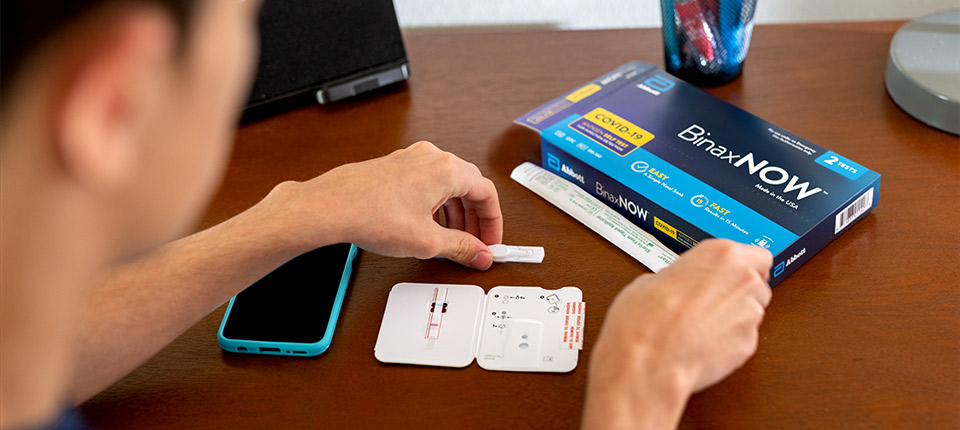Joseph Ravenell, M.D., serves as a member of the Abbott Medical Advisory Board on Diversity. He is a general internist, primary care physician and health equity researcher. He also is an associate professor of public health and medicine and Associate Dean of Diversity and Inclusion at NYU Grossman School of Medicine.
Dr. Joseph Ravenell, a member of Abbott's Medical Advisory Board on Diversity, has been involved in health equity research, especially focused on the disparity in care and outcomes for Black men, since he was in medical school. A conversation with his barber led him to start community-based strategies that focus on diagnosing and treating hypertension and colorectal cancer. Meeting people where they're at, like the barbershop, is essential for a culture of conversation, trust and informed consent when it comes to health concerns and care options, he said.
A key to better healthcare for underrepresented groups is to ensure they're included in clinical trials, which are research studies with volunteers who receive medical treatment, medicines or other care.
"A clinical trial is a way for us to understand if a therapy or intervention works and is safe for a particular group of people," Ravenell said.
Relatively few women and people of color participate in clinical trials, which remains a challenge. More diversity is needed and the reason why is simple: "People of different ages, races, and ethnicities may react differently to certain medical products," according to the Food and Drug Administration.
For this reason, Abbott is reviewing study designs and protocols in its own clinical trials as part of its initiative to create a more inclusive clinical trial ecosystem. To do this, Abbott formed a Medical Advisory Board on Diversity featuring medical experts in population health, including Dr. Ravenell, who are deeply knowledgeable about the clinical trial ecosystem. This group will provide counsel on ways to reduce barriers to access among underrepresented communities so that trials become more inclusive across the industry. Here is what Dr. Ravenell had to say about the initiative.
Abbott: What are the primary barriers to the participation of people of color in clinical trials?
There's a history of researchers not doing a good job of making it clear to patients or participants exactly what we want them to do. The reason many participants of color have decided not to participate in research is not because they necessarily don't trust this [process], but because we haven't communicated clearly what participating in a study means for them. Once we reach them, we must communicate clearly exactly what we want them to do and the risks and benefits of participating in this trial. Communicating clearly, I think, is the second biggest barrier after figuring out where we go to identify the populations we want in our studies.
Insurance is another good proxy for access to clinical trials. When you look at which medical centers in which hospitals have clinical trials, the public hospitals generally don't have them. Folks who don't have insurance are not being seen at the hospitals that tend to have the clinical trials. If we want to think of a big intervention target for increasing minority participation in clinical trials, we need to think about how we equip the places where many minority patients and people in low-resource settings go, and we need to go to where they're more likely to be.
Technology, whether access or use, can be another barrier. When we talk about technology, we're talking about broadband access, but I think one form of technology that we probably underutilize when it comes to clinical trials is cellphones. Everyone has a phone. There's this common misperception that minority populations and people who have lower economic means often are not connected, but cellphones are ubiquitous. If we're looking at potential intervention targets for increasing access, I think cellphones are important for us to focus on.
Why should patients, particularly those from underrepresented communities, participate in clinical trials? How do they benefit?
To know how new therapies, drugs and interventions work in a generalizable way, we need to study how these drugs work across diverse populations because that has safety and efficacy implications.
Clinical trials offer an affordable way for patients who otherwise would not have access to some of these new and cutting-edge therapies. A lot of people don't understand the benefits of participating in clinical trials, and they don't understand that they get access to great care, the best physicians, the best hospitals. It's an affordable way to get care.
What is the role of government and regulatory agencies in ensuring more diversity?
There's definitely a role for policy and stakeholders like the FDA and National Institutes of Health — which have a lot of influence on investment in research and development, drug approvals and academic medical centers — to bring about significant change. They're in an incredibly strong position to create policies that say it's important to not only have representative racial and ethnic diversity, gender diversity, but also socioeconomic diversity.
The conversation we're having now in medicine is long overdue. We're talking about race and racial differences, but what exactly are we talking about? I think we are coming to understand that it's less about biological difference and more about social factors. Why can't we ensure that at least some percentage of patients who are included in clinical trials come from low-resource settings or public hospital settings or are economically disadvantaged? Those social and economic factors probably are more determinative of how well someone does with a medication than their biology.
What is your vision for your work in your lifetime?
Success, for me, will have been that we no longer see a disparity in whatever condition we're talking about. One lifetime is just not possible to really shift those mortality curves, but I think if we can at least see that gap close in a meaningful way, that's a legacy I will be proud of.
Whenever I present scientific talks, I start by defining health disparities. More recently, I've been talking about the concept of health equity and health justice. Next, I present a slide of the disparity in mortality, where black men are dying at higher rates of cardiovascular disease (CVD) than white men. I always say, "This is the slide that gets me out of bed in the morning."






FOLLOW ABBOTT